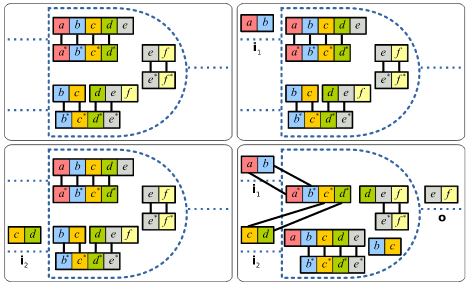Thermodynamic Binding Networks (TBN)
The Thermodynamic Binding Network (TBN) model is a model of molecular computing designed to incorporate the thermodynamic driving forces of enthalpy and entropy in order to ensure that the desired computational output is also the sole thermodynamic equilibrium. The system uses a simplified approach to the molecules themselves by presuming the monomers are unstructured collections of binding sites that are unconstrained by geometry.
Model Definition
A thermodynamic binding network (TBN) is a tuple \(T = (D,M)\), where \(D\) is the set of primary domain types. \(D\) is mapped to a set of complementary domain types \(D^*\) where \(D^* = \{a^* | a \in D\}\). \(M\) is then the set of monomer types, with each monomer type being a set(with the potential for repeated elements) in \(N^{D \bigcup D^*}\), i.e. \(\mathbf{m} \in M\), \(\mathbf{m} = \{a,a,b,b^*\}\), \(a,b \in D\). \(T\) then has monomer collections that consist of some number of each monomer type, and these collections have various configurations corresponding to how the individual monomers bind and form polymers [1].
The TBN model measures which configurations are thermodynamically favored by using the notions of entropy and enthalpy. The enthalpy of a configuration is the number of binding edges, and the entropy of a configuration is the number of polymers.
Results in the TBN
In the figure below there is an AND gate implemented as a strand-displacement model in the TBN. This AND gate implementation has been shown to remain stable when chained indefinitely, which allows the creation of arbitrary Boolean circuits in the TBN [1].
Any TBN \(T = (D,M)\) has been shown to have stable polymers of at most size exponential with respect to the number of domain types \(|D|\) and the number of polymer types \(|M|\). This bound is tight, as a TBN has been demonstrated with exponential stable polymers and it has been shown that a larger factor is impossible [1].
The TBN model is able to simulate any space-bounded Turing machine on any input [2].
References
- ↑ 1.0 1.1 1.2
David Doty, Trent A. Rogers, David Soloveichik, Chris Thachuk, Damien Woods - Thermodynamic Binding Networks
- DNA Computing and Molecular Programming pp. 249--266,2017
- BibtexAuthor : David Doty, Trent A. Rogers, David Soloveichik, Chris Thachuk, Damien Woods
Title : Thermodynamic Binding Networks
In : DNA Computing and Molecular Programming -
Address :
Date : 2017
- ↑ Cite error: Invalid
<ref>tag; no text was provided for refs namedthermo18
Cite error: <ref> tag defined in <references> has group attribute "" which does not appear in prior text.
